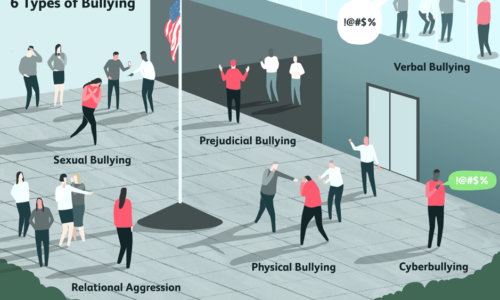The Norwegian researcher Dan Olweus says bullying occurs when a person is “exposed, repeatedly and over time, to negative actions on the part of one or more other persons”. He says negative actions occur “when a person intentionally inflicts injury or discomfort upon another person, through physical contact, through words or in other ways. Individual bullying is usually characterized by a person behaving in a certain way to gain power over another person.
Effects of Bullying
Bullying can cause loneliness, depression, anxiety, lead to low self-esteem and increased susceptibility to illness.
Bullying has also been shown to cause maladjustment in young children, and targets of bullying who were also bullies themselves exhibit even greater social difficulties.
A mental health report also found that bullying was linked to eating disorders, anxiety, body dysmorphia and other negative psychological effects.

Types of Bullying
Cyber bullying
Cyber bullying is any bullying done through the use of technology. This form of bullying can easily go undetected because of lack of parental/authoritative supervision. Because bullies can pose as someone else, it is the most anonymous form of bullying. Cyber bullying includes, but is not limited to, abuse using email, instant messaging, text messaging, websites, social networking sites, etc.
Disability bullying
It has been noted that disabled people are disproportionately affected by bullying and abuse, and such activity has been cited as a hate crime. The bullying is not limited to those who are visibly disabled, such as wheelchair-users or physically deformed such as those with a cleft lip, but also those with learning disabilities, such as autism and developmental coordination disorder
Gay bullying
Gay bullying and gay bashing designate direct or indirect verbal or physical actions by a person or group against someone who is gay or lesbian, or perceived to be so due to rumors or because they are considered to fit gay stereotypes. Gay and lesbian youth are more likely than straight youth to report bullying.
Legal bullying
Legal bullying is the bringing of a vexatious legal action to control and punish a person. Legal bullying can often take the form of frivolous, repetitive, or burdensome lawsuits brought to intimidate the defendant into submitting to the litigant’s request, not because of the legal merit of the litigant’s position, but principally due to the defendant’s inability to maintain the legal battle.
Military bullying
In 2000, the UK Ministry of Defence (MOD) defined bullying as “the use of physical strength or the abuse of authority to intimidate or victimize others or to give unlawful punishments.
Some argue that this behaviour should be allowed, due to ways in which “soldiering” is different from other occupations. Soldiers expected to risk their lives should, according to them, develop strength of body and spirit to accept bullying.
Parental bullying of children
Parents who may displace their anger, insecurity, or a persistent need to dominate and control upon their children in excessive ways have been proven to increase the likelihood that their own children will in turn become overly aggressive or controlling towards their peers.
Prison bullying
An environment known for bullying is in prisons. An additional complication is the staff and their relationships with the inmates. Thus the following possible bullying scenarios are possible:
- Inmate bullies inmate (echoing school bullying)
- Staff bullies inmate
- Staff bullies staff (a manifestation of workplace bullying)
- Inmate bullies staff
School bullying (bullying of students in schools)
Bullying can occur in nearly any part in or around the school building, although it may occur more frequently during physical education classes and activities such as recess. Bullying also takes place in school hallways, bathrooms, on school buses and while waiting for buses, and in classes that require group work and/or after school activities. Bullying can also be perpetrated by teachers and the school system itself; there is an inherent power differential in the system that can easily predispose to subtle or covert abuse (relational aggression or passive aggression), humiliation, or exclusion — even while maintaining overt commitments to anti-bullying policies.
Sexual bullying
Sexual bullying is “Any bullying behaviour, whether physical or non-physical, that is based on a person’s sexuality or gender. It is when sexuality or gender is used as a weapon by boys or girls towards other boys or girls – although it is more commonly directed at girls. It can be carried out to a person’s face, behind their back or through the use of technology.]
Trans bullying
Trans bashing is the act of victimizing a person physically, sexually, or verbally because they are transgender or transsexual.
Workplace bullying
Workplace bullying occurs when an employee experiences a persistent pattern of mistreatment from others in the workplace that causes harm. Workplace bullying can include such tactics as verbal, nonverbal, psychological, physical abuse and humiliation.
In academia
Bullying in academia is workplace bullying of scholars and staff in academia, especially places of higher education such as colleges and universities. It is believed to be common, although has not received as much attention from researchers as bullying in some other contexts.
In blue collar jobs
Bullying has been identified as prominent in blue collar jobs, including on oil rigs and in mechanic shops and machine shops. It is thought that intimidation and fear of retribution cause decreased incident reports.
In information technology
A culture of bullying is common in information technology (IT), leading to high sickness rates, low morale, poor productivity, and high staff-turnover. Deadline-driven project work and stressed-out managers take their toll on IT workers
In the legal profession
Bullying in the legal profession is believed to be more common than in some other professions. It is believed that its adversarial, hierarchical tradition contributes towards this. Women, trainees and solicitors who have been qualified for five years or less are more impacted, as are ethnic minority lawyers and lesbian, gay and bisexual lawyers.
In medicine
Bullying in the medical profession is common, particularly of student or trainee doctors and of nurses. It is thought that this is at least in part an outcome of conservative traditional hierarchical structures and teaching methods in the medical profession, which may result in a bullying cycle.
In nursing
Even though The American Nurses Association believes that all nursing personnel have the right to work in safe, non-abusive environments, bullying has been identified as being particularly prevalent in the nursing profession although the reasons are not clear. It is thought that relational aggression (psychological aspects of bullying such as gossiping and intimidation) are relevant. Relational aggression has been studied among girls but not so much among adult women.
In teaching
School teachers are commonly the subject of bullying but they are also sometimes the originators of bullying within a school environment.

